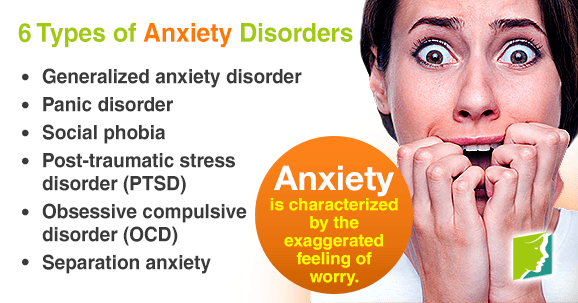Anxiety is a psychological state that is characterized by the exaggerated and persistent feeling of worry, tension, and nervousness, even when there is nothing to provoke these feelings. Anxiety disorders affect more than 40 million Americans on average but they are twice as common in women as they are in men. There are several causes of anxiety in middle-aged women, including hormone fluctuations and stress. These disorders include generalized anxiety disorder, panic disorder, social phobia, post-traumatic stress disorder, obsessive compulsive disorder, and separation anxiety.
Anxiety Causes
The leading cause of anxiety disorders in middle-aged women is hormone fluctuations experienced during menopause. Estrogen significantly affects the brain's regulation of mood and emotions. Subsequently, when a woman's estrogen levels drop and fluctuate, she is at higher risk of mental health disorders.
Additional factors that can prompt anxiety include high stress (either at work or at home), genetics, certain medications, excessive caffeine intake, emotional trauma, lack of exercise, and poor diet.
Types of Anxiety
These are the anxiety disorders that most women suffer from.
Generalized anxiety disorder
This is the most common type of anxiety disorder, and is characterized by consistent feelings of worry, tension, and apprehension about different activities. Sometimes, these feelings of anxiety are unprovoked and irrational.
Panic disorder
This type of anxiety is characterized by panic attacks and overwhelming feelings of fear that come on suddenly. Panic attacks can bring on physical symptoms, like shortness of breath, chest pain, dizziness, and sweating.
Social phobia
Social phobia is defined as the intense fear of being embarrassed in public. This can be triggered by public speaking, eating in public, or any other social situation.
Post-traumatic stress disorder (PTSD)
This type of anxiety follows a traumatic event (war, assault, or bad accident). Symptoms can include nightmares, difficulty relaxing, and flashbacks. However, people who have PTSD may feel stressed or frightened even when they're no longer in danger.
Obsessive compulsive disorder (OCD)
People with OCD experience unwanted and constant thoughts, sensations, and behaviors that drive them to do something repeatedly. People with OCD can't control these obsessions or compulsions.
Separation anxiety
This type of anxiety is characterized by the fear of being away from home or loved ones. When separated from home or major attachment figures, they may recurrently exhibit social withdrawal, apathy, sadness, or difficulty concentrating.
Anxiety Disorders: What Can I Do?
Exercising regularly is the key to reducing stress and releasing “feel-good” neurotransmitters, like serotonin, in the brain. Ideally, people should aim to get 30 minutes of aerobic activity daily, totalling 150 minutes a week. Walking, cycling, and swimming are all good forms of low-impact workouts that can relieve anxiety symptoms. Making simple dietary changes can greatly improve your mood. Including protein, fiber, fatty-acids, and fruits and vegetables into meals is ideal for optimum performance and boosting energy.
Anxiety affects around 25 million Americans on average, and takes on many different forms. Panic disorder, social phobia, and post-traumatic stress disorder are all forms of anxiety. Hormone fluctuations, genetics, and sedentary lifestyle can contribute to the disorder. Exercising and maintaining a healthy diet however, can help ease symptoms of anxiety.
Sources
- Psych Central. (n.d). Separation Anxiety Disorder Symptoms. Retrieved from http://psychcentral.com/disorders/separation-anxiety-disorder-symptoms/
- National Institute of Mental Health. (n.d). What is Obsessive-Compulsive Disorder (OCD)? Retrieved from http://www.nimh.nih.gov/health/topics/obsessive-compulsive-disorder-ocd/index.shtml
- National Institute of Mental Health. (n.d). What is Post-traumatic Stress Disorder (PTSD)? Retrieved from http://www.nimh.nih.gov/health/topics/post-traumatic-stress-disorder-ptsd/index.shtml
- Health. (n.d). Natural Remedies for Anxiety. Retreived from http://www.health.com/health/gallery/0,,20669377,00.html
- National Institute of Mental Health. (n.d.). Anxiety Disorders. Retrieved from http://www.nimh.nih.gov/health/publications/anxiety-disorders/index.shtml
- Office on Women's Health. (2012). Anxiety disorders fact sheet. Retrieved September 5, 2014, from http://www.womenshealth.gov/publications/our-publications/fact-sheet/anxiety-disorders.html




